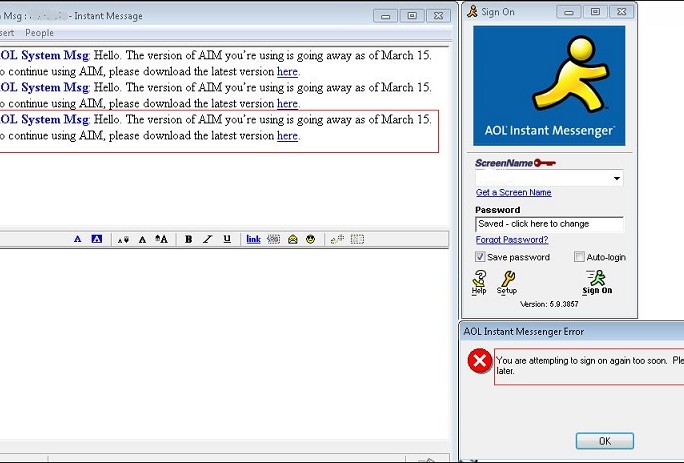This was down to a number of factors. AOL management did not want to offer a product free of charge. It went against the company’s entire ethos. Indeed, AOL management reportedly wanted to kill off AIM and even considered firing Appelman.
It took the strong backing of the development team to get approval for the launch of AIM.
So AOL quietly released AIM in May 1997 with very little fanfare. Indeed, AIM was unceremoniously put on one of the company’s file transfer protocols (FTP), a common way for files to be moved from one computer to another over the Internet.
AIM didn’t even have its own webpage, from which it could be downloaded. But the AOL FTP platform was immensely popular with users, who soon noticed the AIM product sitting there.
Word started to spread, and downloads of AIM grew. Indeed, on the first night the executable code was downloaded over 900 times as the word spread of this product.
When AIM was created, AOL used the proprietary Open System for CommunicAtion in Realtime (OSCAR) messaging protocol. This allowed registered users to communicate in real time.
AIM was initially integrated into AOL Desktop, but such was its popularity that AOL took the decision to release AIM as a stand-alone download in May 1997 for the Windows platform.
Despite this early success, AOL management were unconvinced that a free product was of any value to the firm. Bosco had at this time been promoted to a management position and reportedly had to fight to keep management from pulling the plug on AIM.
It should be remembered that AOL was a consumer focused firm. Its service was spread mostly by freebie floppy discs, and it was competing hard against the likes of Prodigy and CompuServe, in an effort to become the dominant ISP in North America.
Business Use
But with the AIM product, AOL began to find penetration in the business community and it was used by most of Wall Street for a time.
But AIM also was the bane of IT managers, because the product automatically probed for a way to connect if its primary port was blocked.
This meant that AIM would run through all the available ports until it found one that was not, which made it very difficult for IT departments to ban.
AIMs growth continued unchecked and it soon reached as 18 million simultaneous users, mostly in the US.
Indeed, AIM quickly became the dominant messaging program of the late 1990s and early 2000s.
Dirty Tricks?
By now AOL’s management had recognised the power of AIM, and they even acquired another messaging company, Mirabilis, which operated ICQ. And other companies also sought to integrate AIM into their products. The first version of Apple iChat for example was powered by AIM.
But this open nature lead to unwanted attention from Microsoft.
This popularity soon came to the attention of Microsoft however. In 1999 Redmond developed MSN Messenger, which whilst popular in foreign markets, lagged behind AOL in the United States.
But Microsoft had a trick up its sleeve. It made MSN messenger compatible with AIM users. Thus, MSN Messenger launched with the ability to chat with AIM accounts.
And AOL was not at all happy about this, so it tweaked AIM’s system to cut the connection any time it tried to connect to MSN Messenger. But Microsoft updated its MSN Messenger program so that it self-identified as AIM.
AOL once again blocked Microsoft’s attempt. Microsoft’s attempt to make MSN Messenger interact with AIM continued over 21 more updates of MSN Messenger, before AOL threatened to introduce malicious code into MSN’s system.
Licking its wounds, Microsoft eventually signed a deal with Yahoo to connect messaging networks.
In Conculsion
For years AIM was a hugely popular messaging product. Indeed, for many people, AIM was their first taste of instant text-based communications and it made a significant impact on popular culture.
At one stage AIM had the largest share of the instant messaging market in North America, especially in the United States (with 52 percent of the total reported as of 2006).
But AIM’s popularity declined steeply in the late 2000s as social Internet networks like Facebook and Twitter gained popularity. The arrival of Skype and WhatsApp also contributed to AIM’s downfall.
AOL effectively ceased development of AIM in 2012, although the service operated since then with Oath providing support to its users. But like MSN before it, the plug has finally been pulled.
Parent firm Oath decided to discontinue AIM as a service on 15 December 2017.




